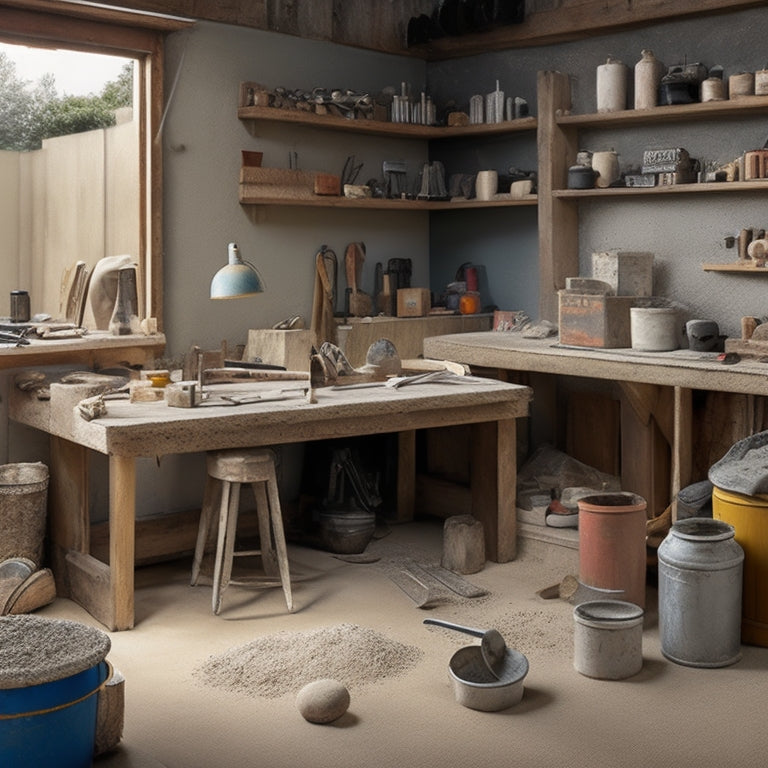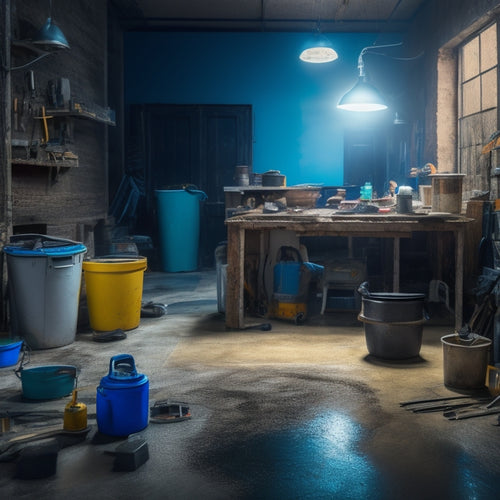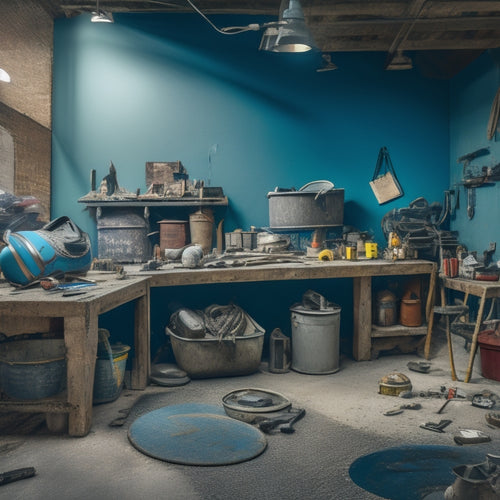
Why You Need These Concrete Tools at Home
Share
When tackling concrete projects at home, you need the right tools to guarantee success. A thorough arsenal of concrete tools is vital to avoid costly mistakes and structurally unsound projects. From mixing bucket essentials to edging and jointing equipment, each tool plays a significant role in achieving a professional finish. Without the necessary tools, you risk encountering air pockets, weak concrete, and uneven textures. By investing in the right tools, you'll be able to tackle projects with confidence and precision. Now that you know what's at stake, you're ready to explore the essential tools you need to get started.
Key Takeaways
• Having the right concrete tools at home ensures a successful and professional-looking DIY project, saving time and money on costly rework.
• Proper mixing and compaction tools prevent defects, air pockets, and weak structures, guaranteeing a strong and durable concrete foundation.
• Edging and jointing tools create clean lines and precise joints, giving your project a polished, professional finish that enhances its overall appearance.
• Essential safety gear protects you from harsh chemicals, heavy materials, and other hazards, minimizing the risk of injury and ensuring a safe working environment.
• A well-stocked concrete toolkit enables you to tackle a wide range of projects, from small repairs to large renovations, with confidence and efficiency.
Mixing Bucket Essentials
When preparing your mixing bucket, make sure it's clean, dry, and free of any residual concrete or debris to prevent contamination and uneven mixing. This guarantees that your concrete mixture is consistent and free of defects.
Next, choose the right bucket size for your project. A bucket that's too small can lead to inadequate mixing, while one that's too large can be difficult to handle. Typically, bucket sizes range from 1-5 gallons, so select one that suits your mixing techniques and project requirements.
When it comes to mixing techniques, it's important to follow a consistent pattern to achieve the right consistency. Start by adding the dry ingredients, then slowly incorporate the liquid components while mixing in a circular motion.
Avoid overmixing, as this can lead to a weak and porous concrete. Instead, mix until the ingredients are just combined, and then stop.
Reliable Tamping Tool Options
With your concrete mixture prepared, you'll need a reliable tamping tool to confirm it's evenly distributed and compacted in the mold or form. A good tamping tool helps prevent air pockets and guarantees a strong, durable concrete structure.
When selecting a tamping tool, consider the type of project you're working on and the size of the mold or form. A handheld tamper is ideal for small to medium-sized projects, while a plate compactor or jumping jack tamper is better suited for larger projects.
It's vital to master proper tamping techniques to achieve the best results. Start by gently tapping the tool against the mold or form to remove any air pockets. Gradually increase the pressure, working your way around the mold to confirm even compaction.
Regular tool maintenance is also important to extend the life of your tamping tool. Clean the tool after each use, and store it in a dry place to prevent rust or corrosion.
Concrete Mixer Must-Haves
You'll need a few essential accessories to optimize your concrete mixer's performance and guarantee a successful pour. Depending on the type of concrete mixer you have, such as a drum mixer or a continuous mixer, you'll want to invest in accessories that enhance its functionality.
For instance, a mixer paddle or mixing blade is a must-have to guarantee thorough mixing and reduce the risk of lumps or uneven textures. You'll also need a mixer cover or lid to protect the mixer from debris and weather elements when not in use.
Regular mixer maintenance is vital to prolong its lifespan and prevent breakdowns. Make it a habit to clean the mixer after each use, lubricate moving parts, and check for worn-out components.
Additionally, consider investing in a mixer stand or wheelbarrow to facilitate easy transportation around the job site. By having these essential accessories and following mixer maintenance tips, you'll be well on your way to achieving professional-grade concrete results.
Leveling and Screeding Tools
Achieving a level and even concrete surface starts with selecting the right leveling and screeding tools for the job. You'll need a combination of tools to guarantee leveling accuracy and a smooth finish. A laser level or spirit level will help you achieve precise leveling, while a screed board or tamping tool will allow you to smooth out the concrete and remove air pockets. It's also essential to have a screed pipe or bull float to further flatten and smooth the surface.
When it comes to screeding techniques, you'll need to work in sections, using long, even strokes to spread the concrete. Make sure to use a consistent motion and apply gentle to moderate pressure, depending on the type of concrete you're working with.
Remember to always work in a well-ventilated area and wear protective gear, including gloves, safety glasses, and a dust mask.
Edging and Jointing Equipment
Once you've achieved a level and smooth concrete surface, it's time to focus on edging and jointing, where specialized equipment helps create clean lines, precise joints, and a professional finish.
You'll need edging tools, such as edgers, jointers, and groovers, to define the concrete's perimeter and create control joints. These tools enable you to achieve precise edging techniques, guaranteeing a professional-looking finish.
For jointing, you'll require jointing irons, jointing trowels, or jointing saws, depending on the jointing methods you're using. These tools help you create precise joints that allow for expansion and contraction of the concrete. By using the right jointing equipment, you can prevent cracks and guarantee the concrete's durability.
When selecting edging and jointing equipment, consider the type of concrete you're working with, the size of the area, and the desired finish. Choose tools that suit your needs and skills, and always follow the manufacturer's instructions.
Safety Gear for Concrete Work
When working with concrete, you'll need to prioritize your safety above all else.
You're about to get up close and personal with harsh chemicals and heavy materials, so it's vital you're equipped with the right gear.
You'll want to focus on the essentials, like protective eye wear and gloves for grip, to guarantee you're protected from head to hand.
Protective Eye Wear
You'll need protective eye wear that meets ANSI Z87.1 standards to safeguard your vision from concrete dust, debris, and chemical splashes. This is essential, as eye injuries can be severe and even lead to permanent vision loss. When choosing protective eyewear, consider the following options:
| Protective Eyewear Options | Description |
|---|---|
| Goggles | Provide full eye protection from dust and debris |
| Safety Glasses | Offer impact resistance and protection from chemical splashes |
| Face Shields | Protect the entire face from flying particles and chemical spills |
| Prescription Safety Glasses | Customizable options for individuals with vision correction needs |
| Over-Glasses Safety Glasses | Designed to wear over prescription glasses for added protection |
Gloves for Grip
With your eyes protected, it's time to focus on your hands, which will be handling heavy concrete tools and materials.
Making gloves with grip a must-have is essential to prevent accidents and injuries. You don't want to risk dropping a heavy tool or losing control of a slippery material, which can lead to serious harm.
That's why gloves with exceptional grip durability are essential for concrete work. Look for gloves made from high-quality materials like synthetic or natural rubber, which provide excellent grip on various surfaces.
These materials will help you maintain control, even in wet or oily conditions. Additionally, consider gloves with textured palms or fingers, which enhance grip further.
When choosing gloves, prioritize grip durability, as it's a critical factor in preventing accidents. Don't compromise on this aspect, as it can mean the difference between a safe and successful project and a hazardous one.
Measuring and Pouring Tools
Measure accurately with a tape measure, calculator, and conversion charts to guarantee your concrete project meets specifications.
You'll need a reliable measuring tape to take precise measurements of your workspace, mixing area, and mold. This will verify you pour the right amount of concrete and avoid costly mistakes. Don't forget to double-check your calculations to avoid errors.
When it's time to pour, a pouring spout is a must-have. This tool allows you to control the flow of concrete, reducing mess and waste.
You'll be able to pour concrete directly into your mold or formwork with ease, saving you time and energy. Additionally, a pouring spout helps prevent concrete from splashing back onto you, reducing the risk of skin irritation and other safety hazards.
Finishing and Smoothing Tools
To achieve a smooth, even finish, concrete finishing and smoothing tools are essential, as they allow you to remove imperfections and excess material from the surface of your concrete project. You'll need a range of tools to master various finishing techniques, such as tamping, edging, and floating. A bull float, for example, helps to flatten and smooth out the concrete, while a hand float is perfect for smaller areas or tight spaces.
When it comes to smoothing methods, you'll want to have a few tools up your sleeve. A steel trowel is great for applying even pressure and achieving a smooth finish, while a concrete edger helps to create clean lines and edges.
Don't forget about a jointer or groover, which allows you to create control joints and prevent cracking.
By investing in these essential finishing and smoothing tools, you'll be able to achieve a professional-looking finish that's both durable and aesthetically pleasing.
With practice and patience, you'll master the art of concrete finishing and be able to tackle even the most complex projects with confidence.
Cleanup and Maintenance Kit
As you wrap up your concrete project, a well-stocked cleanup and maintenance kit guarantees you're prepared to tackle the often-overlooked tasks of removing residue, cleaning tools, and protecting your work. A thorough cleanup guarantees your tools are in top condition for the next project, and your workspace remains safe and organized.
Here are the essential items to include in your cleanup and maintenance kit:
-
A degreaser or concrete cleaner to effectively remove stubborn residue
-
A wire brush or scrubber to scrub away tough stains and grout
-
A soft-bristled brush or cloth for gentle cleaning of delicate tools
-
Safety goggles and gloves to protect yourself from harsh chemicals and rough surfaces
-
A storage container or bucket to keep all your cleaning supplies organized and within reach
Frequently Asked Questions
Can I Use a Drill to Mix Small Batches of Concrete?
Can you use a drill to mix small batches of concrete? Yes, but be cautious.
You'll need a heavy-duty drill with a high torque output, like a hammer drill or impact driver. Use a mixing paddle attachment and follow proper mixing techniques to avoid uneven consistency.
Start with slow speeds and gradually increase as needed.
Always wear safety goggles and gloves to protect yourself from flying debris and concrete splatter.
How Do I Prevent Concrete From Sticking to My Tools?
Did you know that 75% of concrete-related injuries occur due to improper tool handling?
To prevent concrete from sticking to your tools, you're taking an essential step towards safety. Apply a concrete release agent to your tools before mixing, and guarantee you perform regular tool maintenance.
This will prevent concrete from bonding to your tools, making cleanup easier and reducing the risk of accidents. By doing so, you'll save time and stay safe on the job.
What Is the Ideal Temperature for Concrete to Set?
When working with concrete, you need to make certain it sets properly.
The ideal setting temperature is between 50°F and 75°F (10°C and 24°C). Temperature affects concrete's setting pace and strength.
If it's too hot, it'll set too quickly, leading to weaknesses. If it's too cold, it'll set too slowly, causing delays.
You'll achieve the best results by maintaining a stable temperature within this range, making certain of a strong and durable final product.
Can I Reuse Concrete That Has Already Set?
You're probably thinking, 'Why waste good concrete, right?'
But let's get real, can you really reuse concrete that's already set? Unfortunately, the answer is no. You can't just magic it back to its mixable state.
Instead, explore concrete recycling methods that involve crushing and re-purposing old concrete.
When evaluating concrete quality, you'll find it's not suitable for reuse.
How Long Does It Take for Concrete to Fully Cure?
You're wondering how long it takes for concrete to fully cure. The curing process typically takes around 28 days, but it can vary depending on factors like temperature, humidity, and moisture retention.
You'll know it's fully cured when it's reached its maximum strength. During this time, make certain the concrete is kept moist to prevent cracks and promote proper curing.
Keep in mind that full curing can take longer in colder or drier conditions, so be patient and monitor its progress.
Conclusion
As you wrap up your concrete project, remember that 'an ounce of prevention is worth a pound of cure'.
Having the right tools at home can save you time, money, and frustration.
With these essentials, you'll be well-equipped to tackle any concrete task that comes your way.
Don't wait until it's too late; invest in these must-haves and guarantee a strong, durable finish that will last for years to come.
Related Posts
-

Must-Have Tools for Laying Concrete Tiles
When laying concrete tiles, you'll need a range of essential tools to get the job done right. Start with subfloor pre...
-

Essential Tools for Epoxy Concrete Floor Repair
You'll need a thorough arsenal of specialized tools to guarantee a successful epoxy concrete floor repair. Floor prep...
-

What Tools Do You Need for Concrete Flooring
You'll need a thorough arsenal of specialized tools to achieve a high-quality, professional-looking concrete floor, i...


